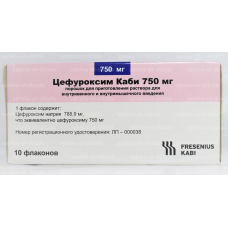Expiration date: 10/2026
Form release
Powder for preparation of solution for intravenous and intramuscular administration
Packaging
10 bottles.
Pharmacological action
Cefuroxime is a second generation cephalosporin antibiotic.
Cefuroxime is active against a wide range of pathogens, including strains producing ?-lactamases.
Bactericidal effect of cefuroxime is associated with suppression of synthesis of bacterial cell wall.
Indications
Bacterial infections caused by microorganisms sensitive to cefuroxime:
- respiratory diseases (bronchitis, pneumonia, lung abscess, pleural empyema),
- ENT organs (sinusitis, tonsillitis, pharyngitis, otitis),
- urinary tract (pyelonephritis, cystitis, asymptomatic bacteriuria),
- skin and soft tissue (erysipelas, pyoderma, impetigo, furuncles, phlegmons, wound infection),
- bones and joints (osteomyelitis, septic arthritis),
- pelvic organs (endometritis, adnexitis, cervicitis),
- sepsis,
- meningitis,
- gonorrhea,
- Lyme disease (borreliosis),
- prevention of infectious complications in surgery on the chest, abdomen, pelvis, joints (including surgery on the lungs, heart, esophagus, vascular surgery at a high risk of infectious complications, orthopedic surgery).
Contraindications
Hypersensitivity to cefuroxime (including other cephalosporins, penicillins and carbapenems).
With caution
The neonatal period, prematurity, chronic renal failure, bleeding and diseases of the gastrointestinal tract (including a history of ulcerative colitis), weakened and depleted patients, pregnancy, lactation, concurrent use of aminoglycosides, by loop diuretics.
Application for pregnancy and breastfeeding
The use of the drug during pregnancy and breastfeeding is possible if the expected benefit to the mother exceeds the potential risk to the fetus and the child.
Special instruction
Patients who have a history of allergic reactions to penicillins may have hypersensitivity to cephalosporin antibiotics.
In the course of treatment, control of renal function is necessary, especially in patients receiving the drug in high doses, in elderly patients with a history of kidney disease, while the use of aminoglycosides and "loop" diuretics. Treatment continues for 48-72 hours after the disappearance of symptoms, in the case of infections caused by Streptococcus pyogenes, the course of treatment - at least 7-10 days.
During treatment possible false-positive direct response Kumbsa and lozhnopolojitelnaya reaction of urine for glucose. In patients receiving cefuroxime, in determining the concentration of glucose in the blood, it is recommended to use tests with glucose oxidase or hexokinase.
Pseudomembranous colitis is observed when using a wide range of antibiotics, the possibility of its occurrence should be borne in mind in patients with severe diarrhea that occurred during or after antibiotic treatment.
Ethanol should not be used during treatment.
With the treatment of meningitis in children may decrease hearing.
In the transition from parenteral to oral administration should take into account the severity of infection, sensitivity of microorganisms and the General condition of the patient. If there is no clinical effect after 72 h from the beginning of treatment, parenteral therapy should be continued.
Ready-to-use solution can be stored at room temperature for 7 hours, in the refrigerator for 48 h allowed the use yellowed during storage of the solution.
Influence on the ability to drive vehicles and management mechanisms
During treatment, care should be taken when driving and engaging in other potentially hazardous activities that require high concentration and speed of psychomotor reactions.
Composition
Active substance: sodium cefuroxime (in terms of cefuroxime) - 0, 75 g
Method of application and doses
Intramuscularly, intravenously.
Intravenously and intramuscularly, adults are prescribed 0.75 g 3 times a day, in severe infections - the dose is increased to 1.5 g 3-4 times a day (if necessary, the interval between injections can be reduced to 6 h). The average daily dose of 3-6 grams per day
Children older than 3 months appoint 30-100 mg/kg / day in 3-4 introduction. In most infections, the optimal dose is 60 mg/kg / day.
Newborns and children up to 3 months appoint 30 mg/kg/day in 2-3 introduction.
Gonorrhoea, intramuscular, adults: 1.5 g once (as 2 injections of 0.75 g with the introduction of different areas, for example, both the gluteus Maximus).
In bacterial meningitis-intravenous, adult-3 g every 8 h, children of younger and older - 150-250 mg/kg/day in 3-4 introduction, newborn - 100 mg/kg/day in 2-3 introduction.
For the prevention of postoperative complications:
- during operations on the heart, lungs, esophagus and blood vessels – intravenous, 1.5 g for the 0, 5 - 1 hour before surgery and 0.75 g intravenously or intramuscularly every 8 hours during long operations over the next 24 – 48 hours (if open-heart surgery the total dose up to 6 g),
- operations on the abdominal cavity, pelvic organs and orthopedic operations-intravenous, 1.5 g with induction of anesthesia, then further-intramuscularly, 0.75 g, 8 and 16 h after surgery,
a full joint replacement – 1.5 g of powder is mixed dry with each pack of methyl methacrylate cement polymer before adding the liquid monomer.
With pneumonia-intramuscularly or intravenously, 1.5 g 2-3 times a day for 48-72 hours, then go to the reception inside (use dosage forms for oral administration) for 0, 5 g 2 times a day for 7-10 days.
In case of exacerbation of chronic bronchitis, intramuscularly or intravenously, 0.75 g is prescribed 2-3 times a day for 48-72 hours, then they switch to oral administration (dosage forms are used for oral administration) 0.5 g 2 times a day for 5-10 days.
In chronic renal failure requires correction dosing regimen in adults: when creatinine clearance (CC) 10-20 ml/min prescribed intravenously or intramuscularly to 0.75 g 2 times a day, with CC less than 10 ml/min - 0.75 g 1 time per day.
In case of chronic renal insufficiency in children, the dosing regimen should be changed in accordance with the recommendations for adults.
Patients who are on continuous hemodialysis using arteriovenous shunt or high-speed hemofiltration in intensive care units are prescribed 0.75 g 2 times a day, for patients who are on low-speed hemofiltration, doses recommended for renal dysfunction are prescribed.
Side effect
Allergic reactions: chills, rash, itching, urticaria, multiform exudative erythema (including Stevens-Johnson syndrome), toxic epidermal necrolysis (Lyell's syndrome), bronchospasm, drug fever, serum sickness, anaphylactic shock, skin vasculitis.
Local reactions: with intramuscular injection-pain, irritation and infiltration at the injection site, with intravenous administration – phlebitis, thrombophlebitis.
From the nervous system: convulsions.
From the genitourinary system: itching in the perineum, vaginitis.
From the urinary system: renal dysfunction (with an increase in the concentration of creatinine and/or urea nitrogen and a decrease in creatinine clearance), dysuria, interstitial nephritis.
From the digestive system: diarrhea, constipation, flatulence, glossitis, nausea, vomiting, cramps and abdominal pain, ulceration of the oral mucosa, oral candidiasis, cholestasis, pseudomembranous colitis.
From the hematopoietic organs: eosinophilia, leukopenia, neutropenia, thrombocytopenia, agranulocytosis, hemolytic anemia, hemoglobin and hematocrit decrease, hypoprothrombinemia, prothrombin time prolongation.
From the sensory organs: hearing loss.
Laboratory parameters: increased activity of hepatic enzymes (alanine aminotransferase, aspartate aminotransferase, lactate dehydrogenase, alkaline phosphatase), hyperbilirubinemia, false positive Coombs test.
Drug interaction
The simultaneous appointment of "loop" diuretics slows down the tubular secretion, reduces renal clearance, increases plasma concentration and increases the half-life of cefuroxime.
While the use of aminoglycosides and diuretics increases the risk of nephrotoxic effects.
Pharmacologically compatible with aqueous solutions containing up to 1% lidocaine hydrochloride, 0.9 % sodium chloride solution, 5 and 10 % dextrose solution, 0.18 % sodium chloride solution and 4% dextrose solution, 5% dextrose solution and 0.9% sodium chloride solution, ringer solution, Hartmann solution, lactate sodium, heparin (10 u/ml and 50 U/ml) in 0.9% sodium chloride solution.
Farmatsevticeski incompatible with aminoglikozidami, a solution of sodium bicarbonate 2.74 %.
Overdose
Symptoms: Central nervous system excitation, convulsions.
Treatment: symptomatic, hemodialysis, peritoneal dialysis.
Storage conditions
In a dry place protected from light, at a temperature not exceeding 25 °C.
Shelf life
2 years.


